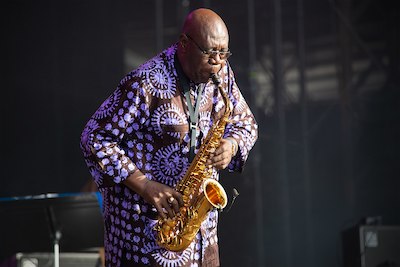Oct 28, 2025 10:47 AM
In Memoriam: Jack DeJohnette, 1942–2025
Jack DeJohnette, a bold and resourceful drummer and NEA Jazz Master who forged a unique vocabulary on the kit over his…

Manu Dibango (1933–2020)
(Photo: Selbymay / CC BY-SA (https://creativecommons.org/licenses/by-sa/4.0))Manu Dibango, the Cameroonian saxophonist who helped expand African music’s global reach by fusing it with jazz, funk, r&b and reggae, died March 24 at the age of 85 after contracting COVID-19. The news was announced on the artist’s Facebook page.
“Dear family, dear friends, dear fans,” the post said. “A voice raises from far away. ... It is with deep sadness that we announce you the loss of Manu Dibango, our Papy Groove.”
Emmanuel N’Djoké Dibango was born Dec. 12, 1933, in Douala, the largest city in Cameroon, which, at the time, was under French colonial rule. His parents—his father, a civil servant; his mother, a seamstress—came from two different ethnic groups, the Douala and Yabassi, but were brought together by their adherence to Protestantism.
Growing up in Douala, Dibango was introduced to the sacred music of the Protestant church, as well as traditional African sounds, but no matter what it was, music instantly grabbed his attention.
“I always liked music, more than football, more than children’s games,” he told Qwest.tv writer Eric Delhaye in 2018. “When I listened to music, I knew it was my thing! [At] the church, the best moment for me was when the master climbed up to the harmonium, put on his glasses and set the score. For someone like me who loved music, that sound was really something.”
At 15, his parents sent him to France to finish his studies, settling at first in Saint-Calais in the northwestern part of the country. It was there that Dibango was introduced to jazz. He became an immediate acolyte, traveling regularly to Paris to watch Sidney Bechet perform and purchasing his first record, a 78-RPM recording of Duke Ellington and His Famous Orchestra performing “Morning Glory.”
Dibango soon turned his attention to music, studying piano and saxophone. He gravitated toward the latter because, as he said, “it’s sexy.” Along the way, he became close friends with Francis Bebey, a fellow Cameroonian expat and guitarist. The two would perform together on the Parisian nightclub circuit.
Dibango’s career didn’t truly get underway until 1956 when he moved to Brussels, where he began melding jazz with the rhythms and spirit of popular African music. That led to a formative tour with L’African Jazz (a Congolese ensemble led by Joseph Kabasele that produced the hit “Indépendance Cha Cha”) and a return to Cameroon, where Dibango began studying Africa’s sundry regional styles.
After returning to France in the mid-’60s, Dibango’s music continued to evolve, as he worked session gigs and joined the band of Franco-Italo pop singer Nino Ferrer. In 1969, he released his leader debut Saxy-Party. But his breakthrough would come three years later, when “Soul Makossa,” a single he recorded to celebrate soccer’s African Cup of Nations, became an unexpected hit. Driven at first by radio airplay and famed DJ David Mancuso working it into his club sets, the song landed at No. 35 on the Billboard Hot 100. The tune’s insistent vocal hook (“ma-mako, ma-ma-sa, mako-mako ssa”) also became the source of Dibango’s other, though an uncredited, claims to fame: an interpretation by Michael Jackson for his pop hit “Wanna Be Startin’ Somethin’” and again by Rihanna on a 2007 single, “Don’t Stop The Music.”
Dibango sued both artists for their actions.
The success of “Soul Makossa” wound up setting the course for the rest of Dibango’s music life: His band was the first African group to perform at the famed Apollo Theater in Harlem, playing a 10-day stand alongside Edwin Starr and the Temptations; he toured with the Fania All-Stars; worked with Latin music legends like vocalists Celia Cruz and Héctor Lavoe; performed at the famed Zaire 74 festival; and recorded a pair of albums in Jamaica backed by Sly and Robbie, and the Brecker Brothers.
Throughout the rest of his life, Dibango’s list of collaborators continued to grow, including a who’s who of African musicians (Ladysmith Black Mambazo, Fela Kuti, King Sunny Adé) and a wide array of pop and jazz artists (Bill Laswell, Peter Gabriel, Eliades Ochoa). His efforts to bridge cultures through sound also earned Dibango a number of honorifics, like his 2004 appointment as a UNESCO Artist for Peace.
As he told journalist Mike Zwerin in 1995, “African musicians retain their roots but are at home everywhere in the world now. Everywhere and nowhere.” DB

Jack DeJohnette boasted a musical resume that was as long as it was fearsome.
Oct 28, 2025 10:47 AM
Jack DeJohnette, a bold and resourceful drummer and NEA Jazz Master who forged a unique vocabulary on the kit over his…

D’Angelo achieved commercial and critical success experimenting with a fusion of jazz, funk, soul, R&B and hip-hop.
Oct 14, 2025 1:47 PM
D’Angelo, a Grammy-winning R&B and neo-soul singer, guitarist and pianist who exerted a profound influence on 21st…

To see the complete list of nominations for the 2026 Grammy Awards, go to grammy.com.
Nov 11, 2025 12:35 PM
The nominations for the 2026 Grammy Awards are in, with plenty to smile about for the worlds of jazz, blues and beyond.…

Drummond was cherished by generations of mainstream jazz listeners and bandleaders for his authoritative tonal presence, a defining quality of his style most apparent when he played his instrument unamplified.
Nov 4, 2025 11:39 AM
Ray Drummond, a first-call bassist who appeared on hundreds of albums as a sideman for some of the top names in jazz…

Jim McNeely’s singular body of work had a profound and lasting influence on many of today’s top jazz composers in the U.S. and in Europe.
Oct 7, 2025 3:40 PM
Pianist Jim McNeely, one of the most distinguished large ensemble jazz composers of his generation, died Sept. 26 at…





